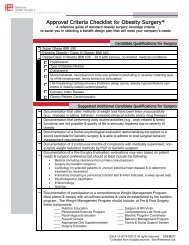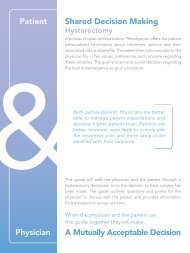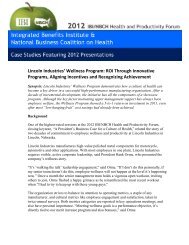Obesity/Weight Management Employer Survey and Interview Project
Obesity/Weight Management Employer Survey and Interview Project
Obesity/Weight Management Employer Survey and Interview Project
- No tags were found...
Create successful ePaper yourself
Turn your PDF publications into a flip-book with our unique Google optimized e-Paper software.
Existing Community Partnerships. Respondentsindicated:E Overall, less than 20% are currently working withcommunity-based organizations or communitycoalitions for assistance or support on theirworkplace obesity activities.E Very large employers (31%) were the most likelyto have these types of partnerships, but this stillrepresented less than a third of the very largeemployer respondents.E Very small (13%) <strong>and</strong> small (16%) employers werethe least likely to have developed partnerships withcommunity-based organizations around obesity orhealthy weight.The results from this question led to more in-depthdiscussion in the interviews. One interviewee was veryaware of community-based programs <strong>and</strong> organizations<strong>and</strong> has in fact built the employer-sponsored wellnessprogram using these as assets to address a wide rangeof education <strong>and</strong> support needs. This interviewee alsomentioned the local public health department as oneof the resources. Other interviewees had little or nocontact with community organizations but were awarethat other employees, such as those in public relations,do have contact. No one noted any link for corporategiving or volunteerism support to health or wellnessspecifically except for sponsorship of an event. Oneinterviewee commented that those sponsorships hadbeen cut back with the downturn in the economy.Benefits of Partnerships. Respondents notedseveral benefits of partnerships in both enhancing ordeveloping workplace obesity prevention <strong>and</strong> controlprograms. The three highest ranked responses were:E Access to useful data <strong>and</strong> information (averagescore of 3.73 out of 5),E Ability to have greater impact than I could have onmy own (average score of 3.69), <strong>and</strong>E Enhanced ability to meet the needs of the workforceor clients (average score of 3.64).Other responses were closely clustered in a midpointarray with the lowest ranking for enhanced ability toaffect public policy (average score of 2.87). <strong>Employer</strong>size did not seem to influence which benefits weremost important to employers. This suggests that thevalue of partnerships is understood, despite the factthat few respondents indicate current communitybasedorganization collaboration. This was supportedby the interviews with the exception of one employerrespondent who uses external organizations as valuedpartners in the employee wellness program. Thesepartnerships, however, are only able to be accomplishedat the corporate headquarters location. In othercompany worksites, there has not been an easy way toaccess or learn about local community resources.Time <strong>and</strong> Resource Barrier. The biggest barriers topartnering with community-based organizations arethe time <strong>and</strong> resources needed (58.1% of respondentsrated this as “always” or “very often” a barrier).The interviews support this view but perhaps moresignificant is the fact that few employers haveestablished relationships with these communityorganizations. This may be part of the reason for thetime <strong>and</strong> resource barrier since the process wouldinclude identification of potential partners as wellas building those relationships as part of the overallprocess. Other barriers include:E 34.2% of employers report insufficient influence inpartnership activities as “always” or “very often” abarrier.E 32.2% of employers report an inability to identifyor access appropriate partners as “always” or “veryoften” a barrier.20National Business Coalition on Health









